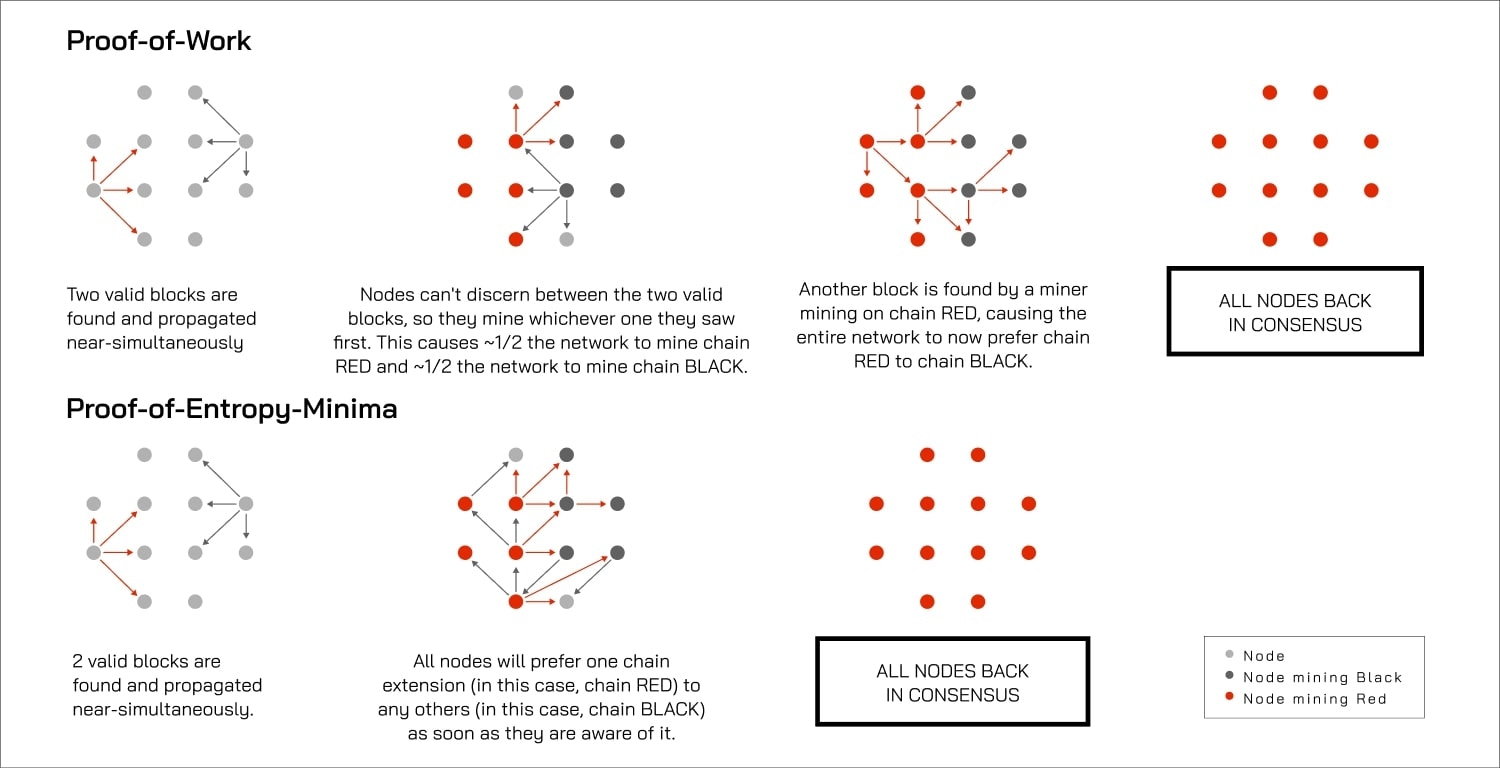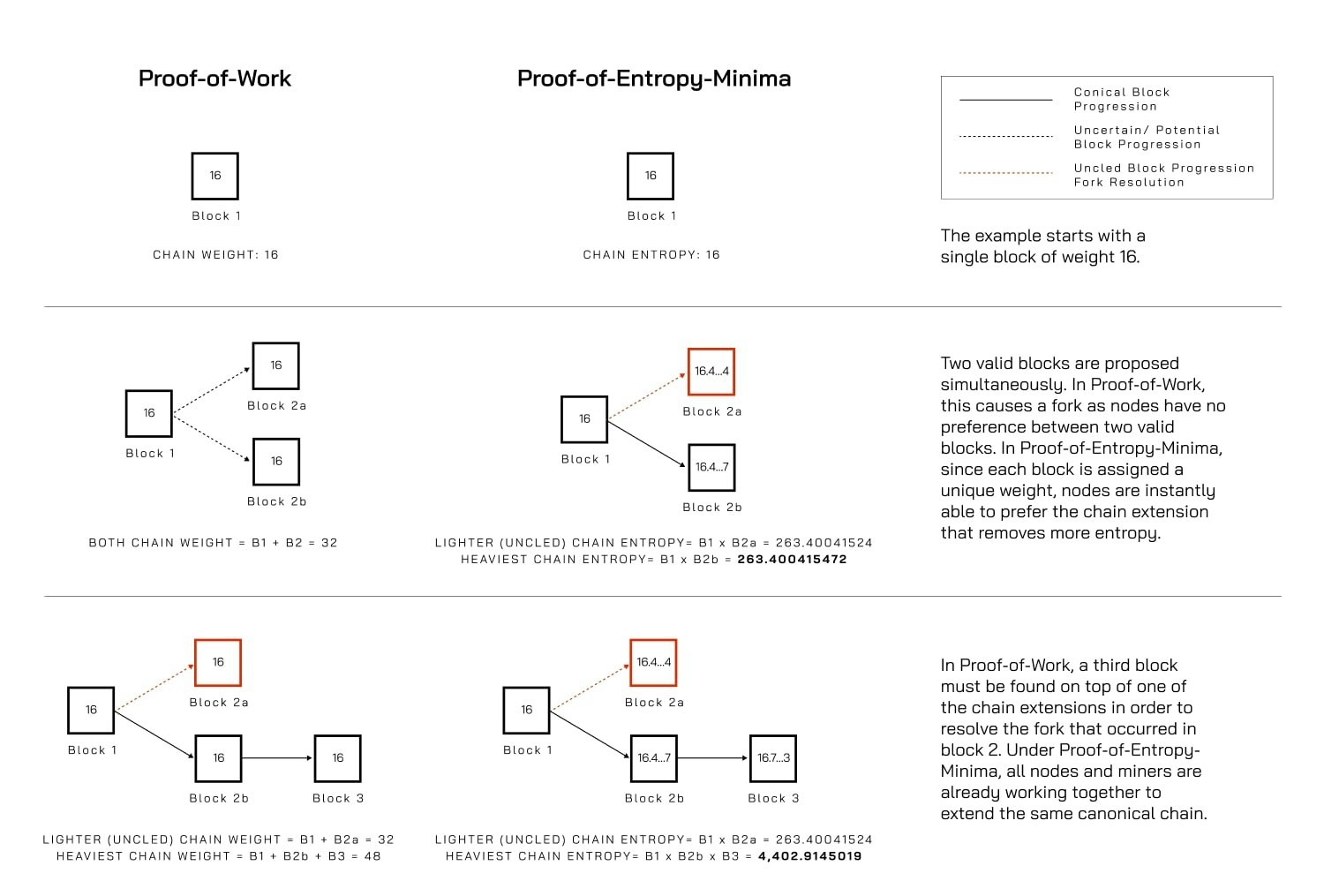Why Fork Resolution Matters
When two miners find valid blocks simultaneously, traditional blockchains face a dilemma: which block should the network accept? This creates a temporary “fork” where the network splits into competing chains. Impact on Users:- Transaction uncertainty: Your transaction might be reversed if it’s on the losing fork
- Delayed confirmations: Must wait for additional blocks to ensure finality
- Higher fees: Network congestion from competing for limited block space
- Wasted energy: Mining power is divided between competing chains
- Reduced rewards: Only miners on the winning fork get paid
- Strategic uncertainty: Unclear which chain to mine on
The Traditional Approach: Wait and See
In Proof-of-Work systems like Bitcoin, when two valid blocks appear simultaneously, there’s no immediate way to choose between them. Both blocks meet the difficulty requirement, so the network must wait:- Split occurs: Miners randomly choose which block to build on
- Network divides: Mining power splits between competing chains
- Resolution waits: Only when someone finds the next block does the network know which chain to follow
- Time cost: This can take 10+ minutes in Bitcoin
PoEM’s Solution: Measure True Work
Here’s the key insight: not all valid blocks are actually equal. Even if two blocks both meet the difficulty requirement, one always required slightly more work to create than the other. Traditional Proof-of-Work ignores this difference and treats “good enough” blocks as identical. PoEM measures the exact amount of work (entropy removed) for each block, allowing instant, objective decisions. How PoEM Resolves Forks Instantly:- Two blocks appear: Both meet the minimum difficulty requirement
- Measure exact work: PoEM calculates the precise entropy removed by each
- Clear winner: The block with more entropy removed is objectively better
- Instant consensus: All nodes immediately know which block to follow
Technical Implementation
PoEM uses intrinsic block weight to measure the exact work done for each block. Instead of just checking “did this block meet the minimum requirement?”, PoEM asks “exactly how much work went into this block?” This precision enables several key advantages: Network Efficiency:- Single proof propagation: Only one block needs to be shared to achieve consensus
- No wasted mining: All computational work contributes to network security
- Perpetual consensus: Nodes always agree on the current chain tip
- Instant coordination: Can manage unlimited parallel chains
- No latency impact: Network delays don’t affect consensus decisions
- Deterministic outcomes: Given the same information, all nodes make identical choices

Perpetual Consensus
By measuring exact work rather than “good enough” thresholds, PoEM fundamentally changes how consensus works. Instead of periodic attempts to reach agreement, PoEM achieves perpetual consensus - all nodes always agree on the current state. This enables unprecedented capabilities:- No fork uncertainty: Users know transactions are final immediately
- Infinite scalability: Can coordinate unlimited parallel chains
- Maximum efficiency: All mining power secures the entire network
- Latency immunity: Network delays don’t create consensus conflicts
Real-World Example

- Both blocks meet the minimum difficulty requirement (16 leading zeros)
- Block A hash:
0x0000b9c86d37... - Block B hash:
0x0000b9c86d30...
How Traditional PoW Handles This:
- Both blocks are valid - Each has 16 leading zeros, meeting requirements
- Network splits - Half the miners work on Block A, half on Block B
- Wait for resolution - Must wait 10+ minutes for someone to find Block 3
- Winner determined - Whichever chain gets Block 3 first becomes canonical
- Work wasted - All mining on the losing chain is discarded
How PoEM Handles This:
- Measure precise work - Block A removes 16.462525964 bits of entropy
- Block B removes more - Block B removes 16.462525967 bits of entropy
- Instant decision - All nodes immediately recognize Block B as better
- Unified mining - All miners switch to building on Block B
- No waste - All computational work contributes to network security
The difference in entropy is tiny (0.000000003 bits) but mathematically decisive. This precision ensures every node makes the same choice without any ambiguity.
